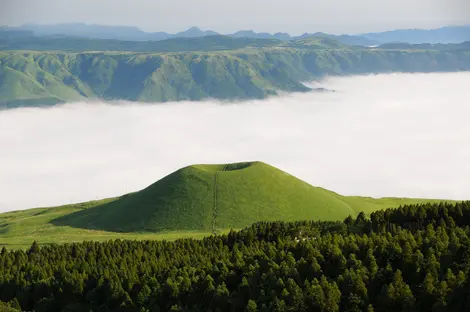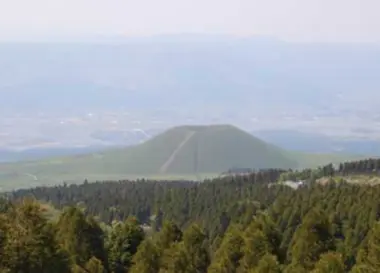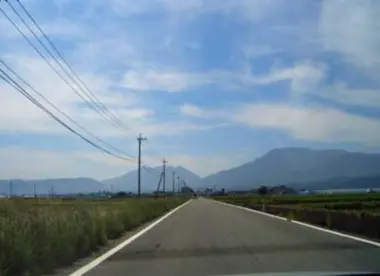Mount Aso Caldera Guide
Aso Caldera: read a guide to the Aso Caldera in Kumamoto Prefecture, Kyushu, the world's largest active caldera with many hot springs.
Japan City Guides: Aso Caldera 阿蘇山
Aso Caldera, Kyushu, Japan
- Huge volcanic caldera - largest active caldera in Japan.
- Situated between Kumamoto and Beppu in Kyushu.
- Area consists of five major peaks.
- Many nearby onsen hot springs.
- Population around 30,000.
- Writer Akiko Yosano spent time here.
Some stations of the Hohi Line from Kumamoto Station to Tateno remain closed after the 2016 earthquake and subsequent damage in heavy rains. From Kumamoto trains go as far as Higo-Ozu Station (40 minutes from Kumamoto Station) from where there are infrequent buses to Aso or take a taxi (See below for numbers of taxi companies). Please consult the JR Kyushu page for further details on services and times (in Japanese)
Mount Aso is a 1,592 meter peak in Aso Kuju National Park in Kumamoto Prefecture on the southern Japanese island of Kyushu.
The first glimpse from the upper edge of the Aso caldera is overwhelming. Coming out of the hilly grasslands surrounding the crater you look into a giant green basin with steep slopes leading down about 100 meters, forming a half-circle in your view, high rocky volcanic shapes rising out of the center.
Right below the slopes, it's table flat, one rice paddy close to the next, like wet blankets laid out to dry. There are houses scattered in between villages, gas stations and shopping malls. It looks so peaceful and yet you understand at first glance that a landscape like that could only have been created in the most violent way.
If you look at a map, you will see that the Aso caldera is in fact almost perfectly round and that the Aso-san mountain range divides it east-to-west into two halves.
Originally, this was the site of a huge, tall volcano. Much, much taller than Mount Fuji or any other mountain in Japan today. That ancient volcano blew itself away in a couple of incredible eruptions. The latest of them occurred about 90,000 years ago and that was the one that shaped the forms you see today.
It must have been a hell of a fireworks display back then - with the debris flying as far as Hokkaido, as recent research has shown, leaving a hole with a circumference of 128 kilometers in the aftermath.
Nakadake Volcano
The Nakadake volcano (1,506m) in the center of the basin is still active, menacingly towering over the peaceful landscape. Only that today you can take a ride up with a gondola there, looking into the smoky crater and inhale a lungful or two of the sulphuric smell the volcano breaths out.
Getting to the giant caldera is already a special trip all by itself. Take the JR Kyushu Odan Tokkyu (Trans-Kyushu Special Express) connecting Kumamoto City with Oita City and finally Beppu. It's an express train only in name.
It's short and cute and painted red and it travels at a very leisurely speed, stopping at even the tiniest spots. On its way, the train will go right through the whole caldera. The slope of the caldera however is much too steep for even such a slow train to go straight down. So, coming from Kumamoto, it goes via a switchback slowly zigzagging back and forth till it reaches the town of Tateno at the lower end of the slope. Something rather rare in the world of railway transportation, I have been told.
If you travel from Beppu, it goes the same way upwards - but in that case you would already have your trip to Aso finished and would be on the way out.
Another option would be to travel with your own vehicle, be that car, motor bike or bicycle. Coming from Beppu or Oita, you would drive or ride along the Yamanami Highway through the gorgeous landscape of the Kuju Plateau before arriving at the upper end of the caldera. Now, you should just follow that upper edge westwards by driving along the Aso Sky Road and then the Milk Road. Those scenic roads offer plenty of view points for a brief stop to indulge in the layout of the land.
Once you have finally made it down the curvy slope road and into Akamizu town all roads stretch out straight in the flat paddy field landscape.
Aso Shinto Shrine
Before heading up the hills again towards Nakadake, you might want to drive a little detour to check out the ancient Aso Shinto Shrine in Aso Town, to get a cultural and historical perspective on the area, as well as the geological one.
Because of its fertile lands, the caldera has been populated from the early days of Japanese history. The shrine itself dates back to the year 280 AD. Not the structure you see today but the shrine as such. For almost 2000 years this has been a place to worship the Shinto gods.
But now on to the Nakadake. From the shrine, drive down highway 111, also known as the Aso Panorama Drive. It soon goes up into the Aso mountains dividing the caldera. Don't miss Mount Komezuka (954m) on the right hand side of the road. Komezuka is one of the most famous sites of Aso; an evenly shaped volcanic cone entirely covered with grass and thus bright green. The road has various viewpoint stops to look at the mountain from above.
Soon after, you will be in barren volcanic territory. Take the access road to the left and it will lead you to the base station of the Aso-san Ropeway (410 yen), the gondola going up to the Nakadake. It will take you right to the edge of the crater with smoke and a pungent, sulphur smell streaming out of it.
The gases emanating from the crater are not considered particularly healthy for your lungs and there are plenty of warning signs saying that all sorts of sickly folks should better not get too close. If you are in good health the gases add greatly to the atmosphere. So do the emergency shelters. Stone bunkers in which to retreat if suddenly the volcano starts spewing out rocks. That doesn't happen very often but it does happen.
You can see the great green basin from up here in a far distance but all around you are just bare stones and gravel fields, the proverbial lunar landscape, so to speak. You can hike over to the mountain top station of the Sensuikyou Ropeway on the other side of the crater. You can see its viewpoints from where you are now at Nakadake.
Aso Hike
But for that, be prepared for a very long hike through absolutely barren landscape, while constantly breathing in gases that have most visitors coughing within a few minutes and holding wet towels to their mouths even when doing the shortest peeks into the crater.
To get to the base station of the Sensuikyou Ropeway by car, the best way is also to start from Aso Shrine. Take the small Sensuikyou Doro and it will take you right there. The base station area is especially famous for the Miyamakirishima plants blossoming in early June. That's a kind of Japanese mountain rhododendron, which looks really good when you see it growing on a steep hill with the full view over the caldera in the background.
The landscape on the top at Sensuikyou Ropeway is the same as that on the other side of the crater. Only that you are higher up here and a bit farther removed from the actual crater. You can't look straight into it from here. But the full smell of the gases you can experience here as well - perhaps even stronger as the wind usually takes them in this direction.
Accommodation in Aso
The Aso area has no shortage of hotels, ryokan and campgrounds. But if you want to experience something really special, head for the Mori no Atelier Hotel in Hakusui Village. That village is part of the greater Minami Aso Village (Minami Aso Mura) in the southern part of the caldera.
You can go there by train as well. *See note at the top of the page on damage to the Hohi Line between Kumamoto and Oita.
Change right after the switchback down into the caldera at Tateno Station to the Minami Aso Tetsudo, a tiny private railway line. Ride that train to what is arguably the railway station with the longest name in all of Japan: Minami Aso Mizuno Umareru Sato Hakusui Kougen Eki.
The hotel has its own hot spring baths which might be just the right thing to dip into after walking through the dust and gases up on the volcano. As nice as those baths are, they are not the main attraction of the hotel however. That would be the 6m telescope belonging to the place. It's the largest privately owned telescope in Japan as well as the biggest on Kyushu island.
The hotel is owned by astronomer Takashi Miyamoto and he operates here his Minami Aso Runa Tenmondai (South Aso Lunar Observatory). After dinner, once night falls, he will do a personal tour of the telescope for the hotel guests himself. You will be able to look through the big lens to see the stars - provided it is a clear night, of course.
You can scan the details of the moon in incredible close-up and yes, it looks just like the landscape up on Nakadake. You can peek out towards more distant stars and planets of which the Saturn is certainly the most impressive. Yes, you can see the ring around that planet clearly and it shines wonderfully in a bright golden hue against the black night sky.
Of course, which planets and stars you are able to see depends on the year and the season you visit. Those things move constantly, after all.
But then, the landscape of the Aso is not permanent either. One day, the Nakadake volcano will change the topography here again. It will be a beautiful, terrible day and all the current maps will be history.

























